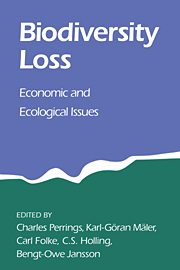Book contents
- Frontmatter
- Contents
- Foreword
- Preface
- List of contributors
- Introduction: framing the problem of biodiversity loss
- PART I CONCEPTUALISING DIVERSITY AND ECOSYSTEM FUNCTIONS
- 1 Diversity functions
- 2 Biodiversity in the functioning of ecosystems: an ecological synthesis
- 3 Scale and biodiversity in coastal and estuarine ecosystems
- PART II INTEGRATING ECOLOGY AND ECONOMICS IN THE ANALYSIS OF BIODIVERSITY LOSS
- PART III ECONOMIC ISSUES
- PART IV CONCLUSIONS
- References
- Index
1 - Diversity functions
Published online by Cambridge University Press: 05 June 2012
- Frontmatter
- Contents
- Foreword
- Preface
- List of contributors
- Introduction: framing the problem of biodiversity loss
- PART I CONCEPTUALISING DIVERSITY AND ECOSYSTEM FUNCTIONS
- 1 Diversity functions
- 2 Biodiversity in the functioning of ecosystems: an ecological synthesis
- 3 Scale and biodiversity in coastal and estuarine ecosystems
- PART II INTEGRATING ECOLOGY AND ECONOMICS IN THE ANALYSIS OF BIODIVERSITY LOSS
- PART III ECONOMIC ISSUES
- PART IV CONCLUSIONS
- References
- Index
Summary
Introduction
“Loss of diversity” is a much lamented condition nowadays. One sees such a phrase applied loosely in a variety of contexts, including the realms of biological species, landmark buildings, historic sites, languages, artifacts, habitats, even ways of life. Often there is an implicit injunction to preserve diversity because it represents a higher value than other things, which by comparison are “only money”. Yet the laws of economics apply to diversity also. We cannot preserve everything. There are no free lunches for diversity. Given our limited resources, preservation of diversity in one context can only be accomplished at some real opportunity cost in terms of well-being forgone in other spheres of life, including, possibly, a loss of diversity somewhere else in the system.
Actual implementation of any injunction to “preserve diversity” is hampered by the lack of an operational framework or objective function. We need a more-or-less consistent and usable measure of the value of diversity that can tell us how to trade off one form of diversity against another.
It would be naive to expect that resolution of real-world conservation choices will reduce to some mechanical application of diversity functions. Yet, I would argue, it is still useful to think in terms of a model that might serve as a paradigm for guiding and informing conservation decisions, even if the model must be at a high level of abstraction.
- Type
- Chapter
- Information
- Biodiversity LossEconomic and Ecological Issues, pp. 21 - 43Publisher: Cambridge University PressPrint publication year: 1995
- 7
- Cited by



